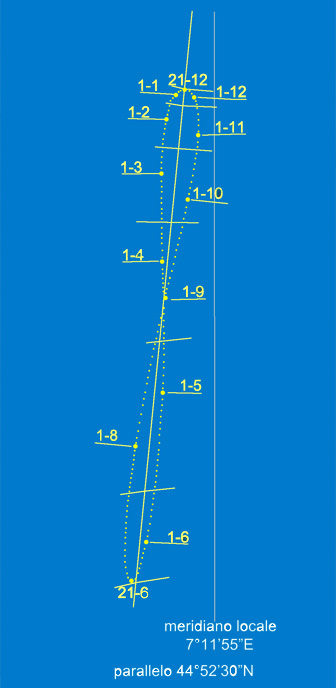
 / Home / Novità / Itinerari con mappe / Astronomia / Natura / Parole e ... piemontese / Contatti / |
| versione italiana | ||||||||||||||||||||||
ANALEMMA. . . stars’ dance up there in the sky Sun - Planets - Moon - Going back to the Sun |
||||||||||||||||||||||
| The “analemma” is a strange shape drawn in the sky by the path of a star during the whole year. Let’s begin from the Sun. | ||
| Only some experienced and patient photographers have managed to pictures this phenomenon. It is not easy to obtain it, not even now with high tech equipment; at least two years are required in order to get a good result, an average of one picture every 6-10 days (allowed by favourable weather). The first image goes back to 1978-79 and it is from Mr. Dennis di Cicco. You need to take different photogram on the same plate (negative) in order to highlight the positioning sequence of the Sun on the same image. The Sun is not in the same position of the sky during the whole year. An observer can notice an apparent movement from East towards West because of the rotation of the Earth, further it is more obvious its annual movement due to the inclination of the Earth rotation axis (23,5°) that makes the Sun declension varying (i.e. the Sun height position in the sky). In the North hemisphere, the Sun is in the highest position at the summer solstice (in June) and it is in lower position at the winter solstice (in December). The average positions occurs at the equinoxes, in March and in September, when the Sun is passing on the vertical of the terrestrial equator. The speed that it is not constant influences the apparent movement of the Sun (even if this effect it is more difficult to see) and it is due to the eccentricity of the terrestrial orbit. Because of keplero rules the Earth speed is greater at the perihelion in winter and it is smaller at the aphelion in summer, when the Earth is more far from the Sun. The track is verified with a not homogeneous run in the sky: in fact the Earth during the Spring covers the longest length of the orbit in 93 days with an average speed of 29,8 km/s, during the summer it spends 93 days with an average speed of 29,3 km/s, during autumn it spends 90 days with an average speed of 29,8 km/s, during winter it spends 89 days with an average speed 30,3 km/s (to the perihelion, closer to the Sun). Photographing the Sun at the same hour of the day during the whole year and grouping the pictures only in one image, a shape called “Analemma” will be obtained; this shape looks like a stretched not symmetric “8”, with a circular loop smaller than the other one. |
||
 |
||||||||||
| At ours latitudes this shape is more or less oblique compared to the horizon depending to the chosen hour: rotated on the left if the picture is done in the morning, vertical if done at midday, instead rotated on the right if pictured in the afternoon. Summarising: the vertical coordinate of each point corresponds to the declension (or height position) of the Sun in that day, while the horizontal coordinate indicates the shifting of the solar position, in advance or in delay, respect to the average hour (the time shown by the watch). On the side and below there is the analemma that is present at Colle Vaccera 1461m (TO-Italy) |
||||||||||
 |
||||||||||
| The vertical line on the right represents the symbolic track of the plan of the local meridian. Considering the place’s longitude, the solar midday and the mechanical watches differ by 31 minutes and 12 seconds. The oblique yellow left line indicates the middle datum of the midday of the time zone. Around this line a curve is sketched with the approximate shape of a crushed 8 that rectify the daily real shifting of the Sun compared to the Meridian line (according to the table of the Equation of the Time, extracted from the Keplero rule and related to the elliptic movement of the rotation of the Earth compared to the Sun). Data about the days of the months are reported too. To read correctly the analemma you need to observe the bright beam passing through the Gnomon (the perforated circle). Its height will determine the day and, depending to the month, before or after midday the bright point will be exactly over the stretched curve of the 8. |
||||||||||